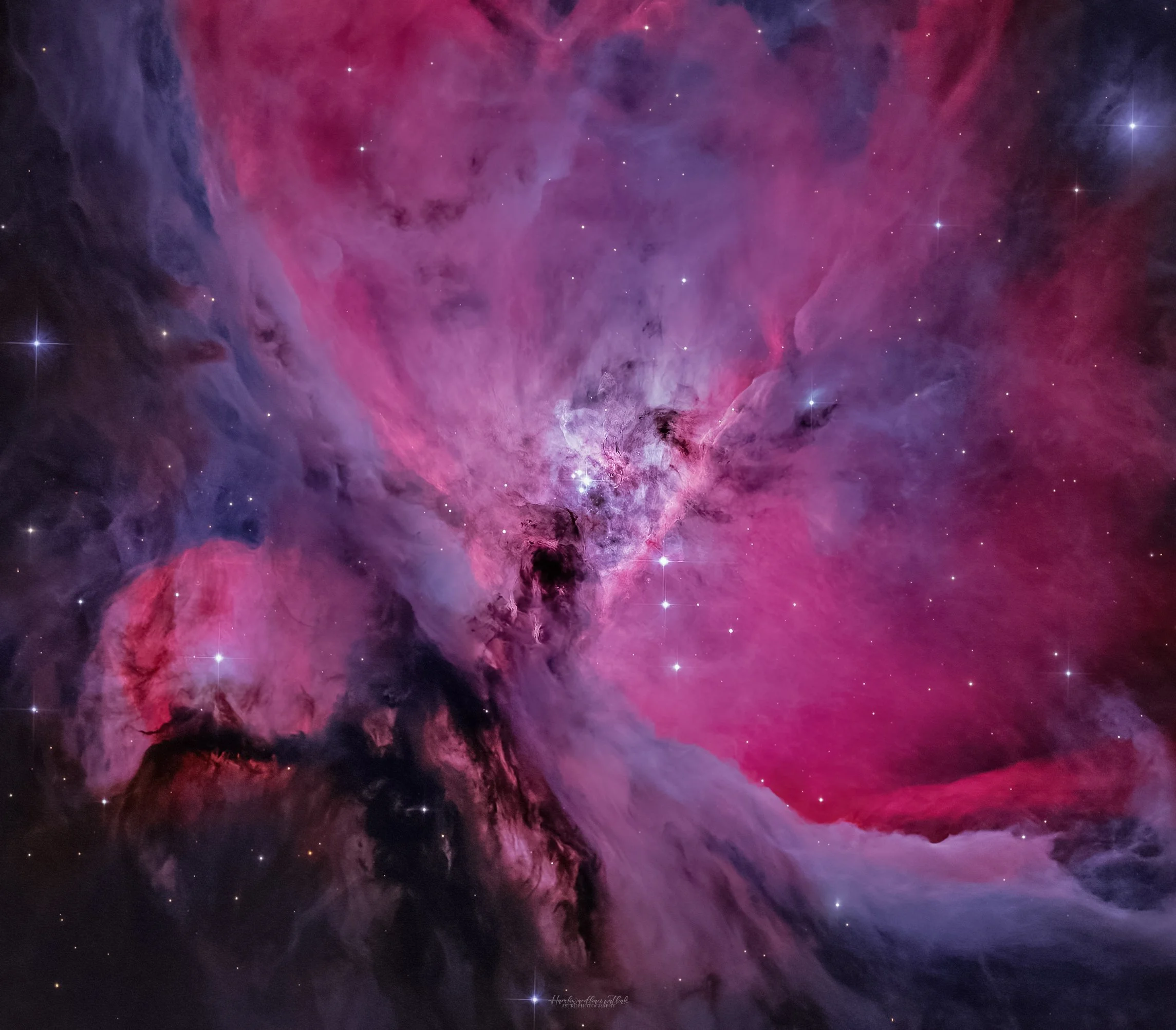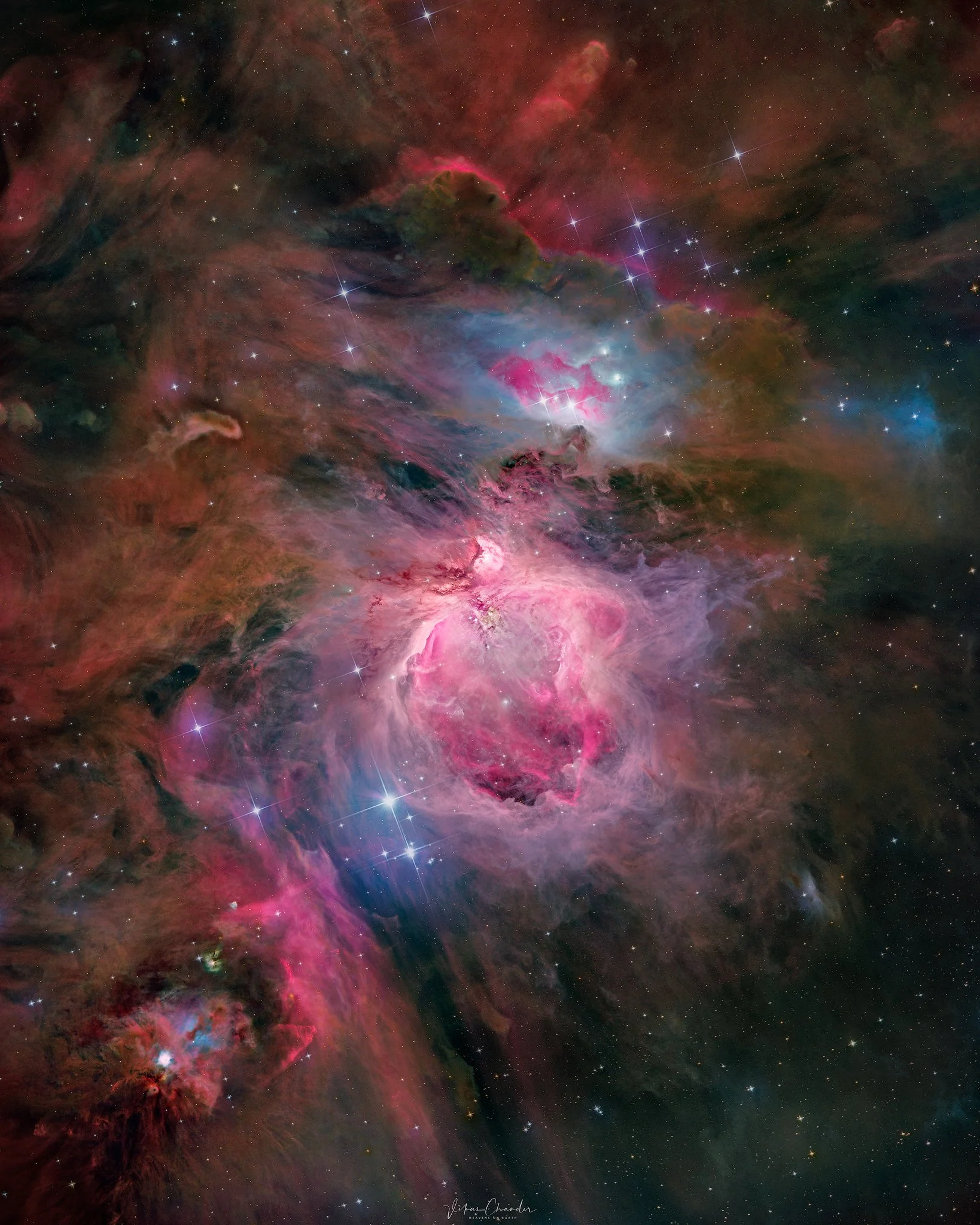
AAPOD2 Image Archives
Core Of Orion Nebula
This image offers an intimate view into the core of the Orion Nebula, a stellar nursery located in the sword of the iconic Orion constellation. Captured through Planewave CDK24 and FLI PL 9000 ccd camera, the image reveals a tapestry of luminous gas and dust, illuminated by the energetic radiation of newborn stars. At the heart of this celestial forge, the Trapezium Cluster, a grouping of hot, massive stars, dominates the scene, sculpting the surrounding nebula with their intense stellar winds and radiation. The intricate details captured in this image not only showcase the breathtaking beauty of the Orion Nebula but also provide astronomers with valuable insights into the processes of star formation and the dynamic interplay of young stellar systems.
Orion
The Orion Nebula is a vast and colorful cloud of gas and dust located in the constellation Orion. It is one of the most famous and easily recognizable nebulae in the sky, and is often referred to as the "Great Nebula in Orion" or the "Orion Nebula Cluster".
Difficult to process but done well here, is the Orion Nebula Trapezium, a group of four young hot stars located within the center of the Nebula. The stars, which are known as Theta-1 Orionis A, B, C, and D, are some of the most massive and luminous stars in the Orion Nebula, and are thought to be less than a million years old.
Orion Rising
The Orion Complex is a group of stars and nebulae located in the constellation Orion. Seen here rising over a beautiful campsite. It’s an interesting region for astronomers because it contains a number of bright, young stars that are still in the process of forming. These stars are surrounded by clouds of gas and dust, which are the remnants of the material that originally formed the stars.
The Orion Complex is home to several famous nebulae, including the Great Orion Nebula (aka M42), a spectacular example of a region where new stars are being born. The Orion Complex is a popular target for amateur and professional astronomers because it is visible with the naked eye and contains a wealth of great targets.
Orion Constellation & Barnard loop
Image Description and Details :
Here is my post on this Orion photo and the Barnard loop, I spent the only clear night without a moon to try the samyang 135mm f2, because I wanted to have fun doing astrophotography. I absolutely wanted to shoot the constellation of Orion and the loop of Barnard. It was complicated to image it with a more than hazardous seeing but on 210 shots of 120 seconds I kept only 100 raw. After processing tests, I was happy with my final treatment.
Samyang 135mm at f2.8Canon 6D Iso 1600 Photomax Heq5 pro100 brutes x 120''Copyright: Oliver Globetrotter & P. Bernhard
The outpost
Image Description:
On a rocky summit of an icy planet sits a remote research outpost. This frozen world orbits a inconspicuous star in a minor arm of a giant barred spiral galaxy.
Named after a mythical creature of an ancient culture that once dominated the planet, this scientific outpost is called the Sphinx. The Spinx is mythicized to have mercilessly killed those who couldn't answer her riddle.
The Sphinx station has a prime view on one of the galaxies major star forming regions, named after another mythological figure, a giant hunter. Not all scientific riddles within the hunter are solved yet, but fortunately the Sphinx hasn't killed any scientists so far.
The thin atmosphere of the planet at this high altitude location contains enough water to form clouds, which shroud the observatory in freezing fog about 40% of the time. If the clouds part, the hunter's giant molecular clouds of ionized hydrogen are lighting up the sky.
I had the opportunity to visit the Sphinx outpost with benjaminbarakat in September for a night of astrophotography. After a sternous night, we were happy that both the planet and the mythical creatures had shown mercy. The hunter had made its appearance and we escaped this stunning place without getting killed by lack of oxygen, the cold or the wrath of the Sphinx.
EXIF
Canon EOS EOS Ra
Canon 24-70mm f/2.8 L ll @ 50mm
iOptron SkyTracker Pro
Sky:
4 panel panorama, each a stack of 7 x 60s @ ISO1600
Foreground:
Panorama of 4x 2s @ ISO400 during blue hour
Copyright: Ralf Rohner
The Great Orion Nebula and Running Man
The Orion Nebula (also known as Messier 42, M42, or NGC 1976) is a diffuse nebula situated in the Milky Way, south of Orion's Belt in the constellation of Orion.







